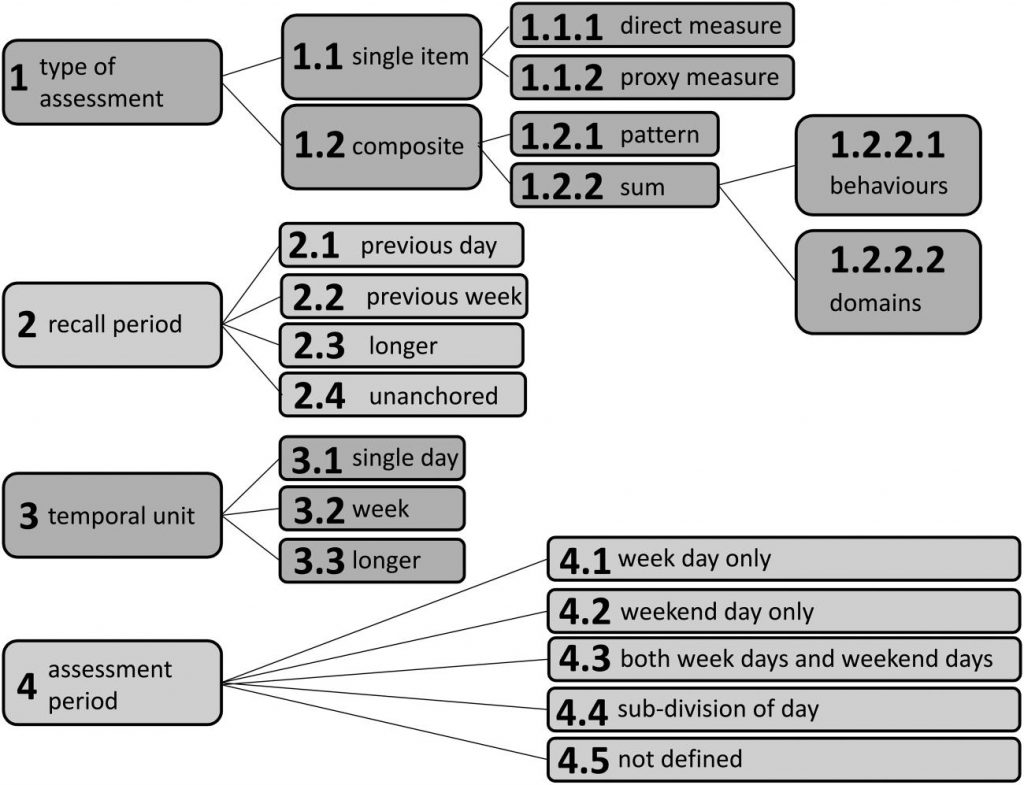
VitaBit-A new alternative for measuring sedentary behavior
April 23, 2018
Reallocating time between sleep, sedentary and active behaviours: Associations with obesity and health in Canadian adults
May 7, 2018Today’s post comes from Dr Manon Dontje. You can find more information on Dr Dontje at the bottom of this article.
These days, more and more information is getting publicly available about the detrimental health effects of prolonged sitting. As a researcher focusing on sedentary behaviour, people often ask me “How long should I sit for?”. Their next question is usually “..and how should I measure this?”. Well, measuring sedentary behaviour (using a questionnaire) is not as easy as it may seem.
Measuring sedentary behaviour is tricky
Just to give an example: can you remember what you ate last Monday? Probably not, unless you eat fish and chips every Monday. Similarly, would you be able to tell how much time you spent sitting last Monday? Probably not either. Unless you do the same activity (like sitting) every day you probably don’t remember it very well. Sitting is something you do unconsciously, and it is spread out across the day. I would be surprised if you consistently look at the clock every time you sat down and stood up.
So yes, it may be tricky to remember exactly how much time in total you spent sitting on a particular day. It may be easier to remember how much time you spent sitting watching TV, or how much time you spent sitting and reading a book, but how does that relate to your total sitting time?
Researchers have developed, and are using, a large number of different questions and questionnaires to measure sitting time, but it seems we don’t really know what the best way is. If you ask someone for advice about which questionnaire you should use to measure sitting time in your study, the answer usually starts with “well, it depends…”. That is why our team (Seniors USP) went to great lengths to be able to give a better answer to the question “What is the best questionnaire to measure sedentary behaviour?”.
A framework to guide the choice of questionnaire
There are many different ways to ask about sedentary time. For example, some of the questionnaires include questions about the total time spent sitting, others focus more on specific sedentary activities. Some questionnaires ask about the time spent sitting yesterday, others focus on last week. Sometimes the focus is on time spent sitting on a single day, sometimes the focus is on the time spent sitting per week. They can also differ in their approach of including weekdays only or including both week – and weekend days.
We systematically evaluated and compared all self-reported sedentary behaviour tools that are suitable for an adult general population. We were able to create a framework that captured and summarised the characteristics of all these tools in four domains: type of assessment, recall period, temporal unit, and assessment period (Fig 1). More information about this Taxonomy of Self-reported Sedentary behaviour Tools (TASST) framework can be found here. This framework can be used to compare measurement characteristics of different tools and can guide researchers in their choice of questionnaire. Each questionnaire can be described by full or partial taxa of the TASST framework. The literature to date provides measurement characteristics information for at least eight distinct full taxa. And thus, even when there is no information about the measurement characteristics of a specific questionnaire, the TASST framework can still help to decide if this is a suitable questionnaire for your study.

Figure 1 Taxonomy of Self-reported Sedentary behaviour Tools (TASST framework) (Dall et al.,BMJ Open 2017;7:e013844)
How accurate are questionnaires?
The TASST framework also clearly identified the gaps in literature. These gaps included a lack of information about the most important measurement characteristics necessary to assess which method is the best, i.e., accuracy and sensitivity to change. Therefore, we set up a large validation study (Chastin et al., 2018). In this validation study we compared a sample of 18 self-report measures of sedentary time (i.e., 6 types of assessments and 3 recall periods) representative of all the characteristics that we identified with the TASST framework, against an objective measure of sedentary time. In total, 773 older adults participated in this study, and 700 datasets were analysed. We showed that the accuracy of all self-reported measures was poor. Most of the self-reported tools grossly underestimated the time someone spent sitting, sometimes up to almost 8 hours! In other words, even though people might indicate that they sat for only 2 hours a day, it might actually have been 10 hours a day.
How to correct the inaccuracy of questionnaires
Thankfully, because we measured people’s actual sitting time as well using objective body-worn sensors we were able to calculate correction factors for every self-reported tool in the taxonomy. For example, the answer to a simple question like “How much time did you spend sitting yesterday?” needs to be corrected with +4 hours to get a more accurate estimate of the actual time spend sitting. Similarly, the answer to the question “How much time do you spend sitting and watching TV on a usual day?” needs a correction of almost + 7 hours! Using the correction factors enables researchers to obtain a more accurate estimate of sedentary time. In turn, this makes it easier to make better comparisons between studies using different tools.
If we interpret accuracy as something that can be corrected at a group level, using the factors published, then other metrics become important in selecting the most appropriate questionnaire. By mapping the precision (how small the error was on individual differences between questionnaire and objectively measured sedentary behaviour) and data loss (how many questions weren’t filled in or gave infeasible answers), we found that the best measures are ones that ask about sitting as a single item, and a visual analogue scale asking about the proportion of time spent sitting (Fig 2). These methods had the best combination of low error and data loss. The recall period that you asked people to remember their sitting over did not matter so much.

Figure 2 Example of visual analogue scale to measure sitting time as proportion of the day
How do you measure and interpret changes in sedentary behaviour?
Then one more question remained; how do you measure and interpret changes in sedentary behaviour? Suppose your measurements show that a person was sedentary for 6 hours one week, and for 5 hours the next week. How can we be sure that the one-hour difference was actually caused by the person sitting less instead of it being an error in the way it was measured? Or was the difference caused by the natural day-to-day variability, for example because the first measurement day was the day someone usually sat more because they always played chess for 2 hours, while the other day was a day this person usually sat less because they always played golf for 2 hours? You can only be sure that the difference is a real change in behaviour if that difference is larger than the measurement error (this includes the day-to-day variability). In other words, if the one-hour difference is larger than the measurement error, we can be sure there has been a real change in behaviour.
In our validation study we already showed that there is a large measurement error when sedentary behaviour is measured with a self-reported tool. How this measurement error impacts the ability of a measurement tool to measure and detect change, depends on a few things. First, it is important to consider if it is about change of one individual or of a group (who). Second, will the measurements be contrasted over time (within-subject design) or at one point in time (between-subject design) (which)? And the third point to consider is whether the observed change or the clinically relevant change will be quantified (what).
Taking these Who-Which-What questions into account we were able to rank 6 self-reported tools for different study designs from best to worst. An overview of the detailed recommendations for different study designs can be found here. Overall, asking about the time spent watching TV on an average day in the previous week is the self-reported method that is most responsive to change in a clinical setting, a quasi-experimental or longitudinal study setting, and in a controlled trial setting. However, there is a caveat: TV viewing is only a small part of the total time someone spends sitting. A change in TV time does not guarantee a change in the total time someone spend sitting during the day. In other words, if you are interested in assessing change in the total time someone spends sitting per day, assessing TV viewing time is not the most informative method.
What is the best questionnaire to measure sedentary behaviour?
So, coming back to the key question “What is the best questionnaire to measure sedentary behaviour?”, we can now give a more specific answer, but “…it still depends…”(I am sorry, but it is true!). It depends on several factors, including the aim of your study, your study design, the type of sedentary behaviour you are interested in, and whether you are interested in measuring change. If you have made up your mind about all these factors, then our research can point you in the direction of the best available tools. For example, if the primary aim of you study is surveillance and you are interested in total sitting time, a question about the proportion of sitting using a previous day or previous week recall would be the best choice of measurement. If you are more interested in specific behaviours but an estimate of total sedentary time is still required, then you should choose a questionnaire with composite measures of sedentary behaviour. If you are interested in measuring and interpreting change of an individual in a clinical setting you will get the best results when you ask about the time spent watching TV the previous day or week. More detailed recommendations can be found in Fig 3 and the published papers, but perhaps the take home message from this blog post is that to choose the most appropriate method to measure sedentary behaviour all measurement characteristics (accuracy, reliability and responsiveness) should be balanced in a way that suits the specific aim and design of the study or surveillance.

Figure 3 Decision of flow chart for choice of self-report instrument to measure sedentary time (Chastin et al., International Journal of Behavioral Nutrition and Physical Activity, 2018;15:21)
References
Dall PM, Coulter EH, Fitzsimons CF, Skelton DA, Chastin SFM, on behalf of the Seniors USP team. TAxonomy of Self-reported Sedentary behaviour Tools (TASST) framework for development, comparison and evaluation of self-report tools: content analysis and systematic review. BMJ Open, 2017;7:e013844.
Chastin SFM, Dontje ML, Skelton DA, Cukic I, Shaw RJ, Gill JMR, Greig CA, Gale CR, Deary IJ, Der G, Dall PM, and on behalf of the Seniors USP team. Systematic comparative validation of self-report measures of sedentary time against an objective measure of postural sitting (activPAL). International Journal of Behavioral Nutrition and Physical Activity, 2018;15:21.
Dontje ML, Dall PM, Skelton DA, Gill MR, Chastin SFM, on behalf of the Seniors USP Team. Reliability, minimal detectable change and responsiveness to change: Indicators to select the best method to measure sedentary behaviour in older adults in different study designs. PLOS ONE, 2018;13(4): e0195424.
About the author
 Dr Manon Dontje has a background in human movement science and epidemiology. She was involved in the Seniors USP (understanding sedentary patterns) project at Glasgow Caledonian University, in Scotland. She currently works at the University of Western Australia in Perth, Australia, where her research focuses on sedentary behaviour, physical activity, and sleep in middle-aged and older adults. You can follow and connect with Manon on Twitter and ResearchGate.
Dr Manon Dontje has a background in human movement science and epidemiology. She was involved in the Seniors USP (understanding sedentary patterns) project at Glasgow Caledonian University, in Scotland. She currently works at the University of Western Australia in Perth, Australia, where her research focuses on sedentary behaviour, physical activity, and sleep in middle-aged and older adults. You can follow and connect with Manon on Twitter and ResearchGate.



